The Crab with the Golden Claws (French:
Le Crabe aux pinces d'or)
Original publication dates: October 1940 – October 1941
First collected edition: 1941 (redrawn colour edition published in 1943)
Author: Hergé
Tintin visits: Belgium (Brussels), Sahara Desert, Morocco (Bagghar).
Overall rating:





 Plot summary available here
Plot summary available here.
Publisher's synopsis:
A series of mysterious clues put Tintin and Snowy on the trail of a dangerous gang of opium-smugglers. Tintin's daring and cunning sees the adventure take them from the scorching Sahara Desert to the alleys of a Moroccan port.Comments: So, we're into new territory here, because
King Ottokar's Sceptre was the last Tintin review that I wrote for my old review thread, back on the Comic Book Resources forum. As those of you who have been following this thread will know, that series of reviews was lost forever in the 2014 CBR forum reboot, so this is the first time that I've reviewed
The Crab with the Golden Claws.
The first thing I should note is that
The Crab with the Golden Claws was not originally intended to be the follow-up to
King Ottokar's Sceptre. A month after the completion of the previous Tintin adventure, a new story entitled
Land of Black Gold debuted in the pages of the Belgian children's newspaper supplement,
Le Petit Vingtième. However, after running for eight months,
Land of Black Gold was abandoned, when the supplement's parent publication – the staunchly right-wing, Catholic newspaper
Le Vingtième Siècle – was shut down by the Nazis, following Germany's invasion of Belgium in May 1940. Since
Land of Black Gold featured the Germans as the story's antagonists, clearly continuing the adventure, while Belgium was under Nazi occupation, wouldn't have been a wise move for Hergé. Instead, the cartoonist took a job with Belgium's most popular French language newspaper,
Le Soir, and, on October 17, 1940, an all-new Tintin adventure called
The Crab with the Golden Claws began in the paper's children's supplement,
Le Soir Jeunesse (although it later moved to the pages of
Le Soir itself).
Here's the front page of the inaugural issue of
Le Soir Jeunesse, showing Tintin and Snowy determinedly striding along a country road towards Brussels, with a triumphant caption below proclaiming, "Tintin et Milou sont revenus!" ("Tintin and Snowy are back!")...
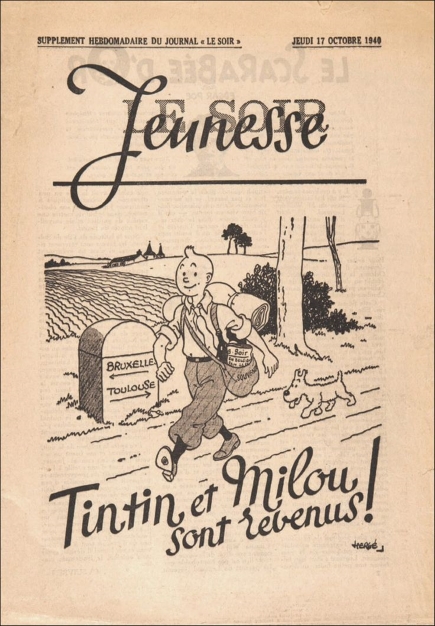
Something else I feel I should note, given the predominantly American membership of this forum, is that
The Crab with the Golden Claws was the first Tintin adventure to be published in the U.S. It was published by Golden Press (an imprint of Western Publishing) in 1959 and here's a photo of that first American edition...
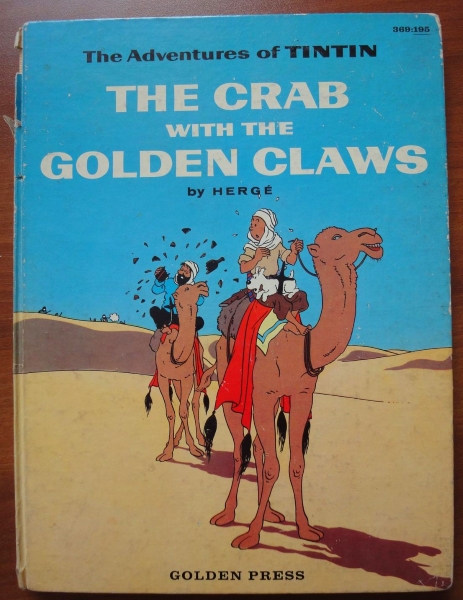
The story begins with Tintin coming into possession of a scrap of paper from a can of crab meat, with the mysterious word "Karaboudjan" scrawled on it and, from there, the boy reporter finds himself on the trail of a desperate gang of opium smugglers. I have to say that the book's central plot is somewhat reminiscent of the earlier two-parter,
Cigars of the Pharaoh and
The Blue Lotus, insofar as Tintin is once again investigating drug trafficking, with the opium being hidden inside cans of crab meat this time, rather than inside cigars, as it was in the earlier tale.
The book gets off to a decidedly lighthearted start, with Snowy getting his muzzle stuck inside a discarded tin of crab meat, after which, the boy reporter meets up with the Thom(p)son Twins and more slapstick humour ensues. There's a sub-plot about counterfeit coins that gets introduced at this point, but as the adventure begins to gather pace, it gets quietly forgotten. This clumsily abandoned sub-plot is reminiscent of the haphazard way in which Hergé used to make his early stories up week by week, with little in the way of any over-arching narrative or idea of where the story was going. The author had long since abandoned that practice, however, favouring carefully plotted stories instead. As such, this forgotten counterfeiting plot represents a degree of sloppiness that we've not seen in Hergé's work since way back in
Tintin in the Land of the Soviets or
Tintin in the Congo.
Once the blithe mood of this adventure has been established, the slapstick routines come thick and fast – particularly from the Thom(p)sons. Tintin too seems uncharacteristically absent-minded in a scene where he accidentally mixes up his magnifying glass with Snowy's bone, and Hergé very much plays this for laughs...
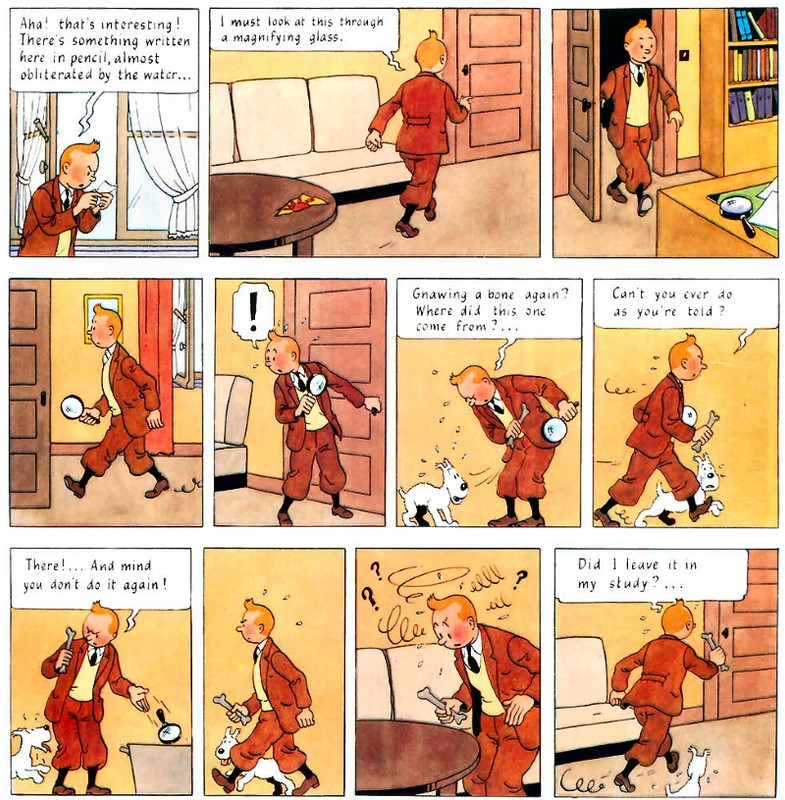
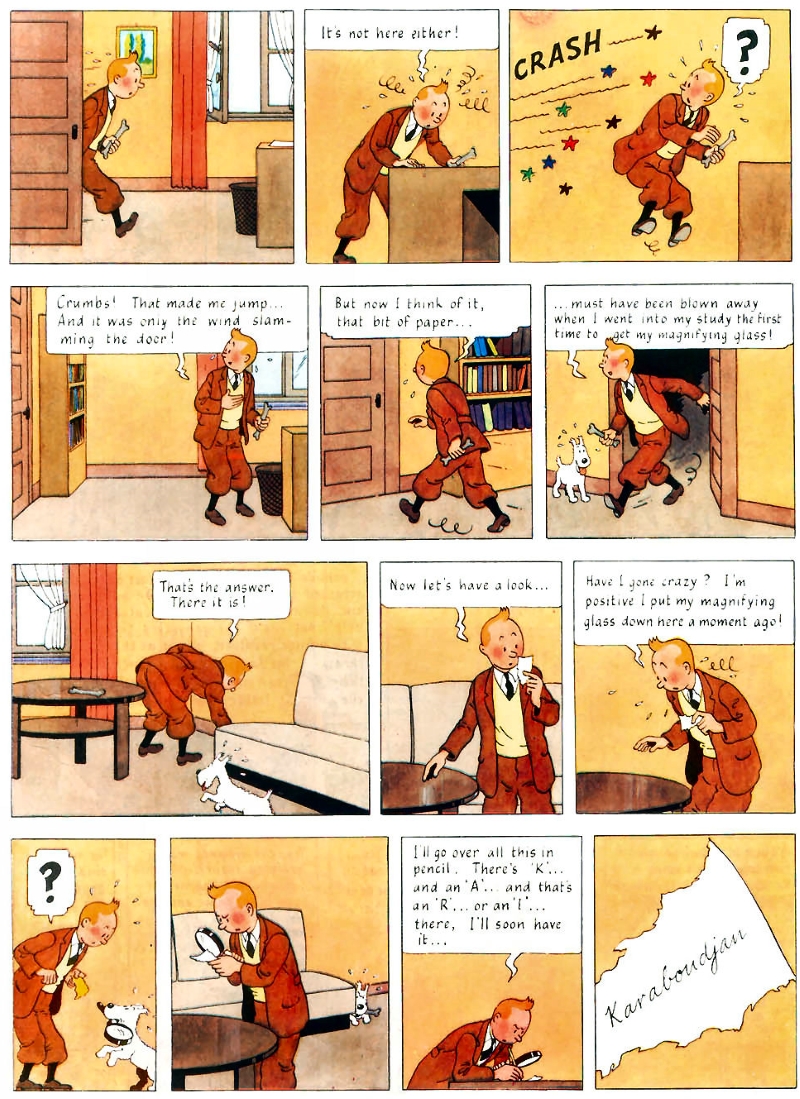
The trouble is, I don't find a lot of this silly, slapstick humour to be overly funny. There's more slapstick and physical comedy than ever in
The Crab with the Golden Claws, and, for me, it slows the pace of the story down a little too much. By contrast, some of the less silly comedy in the book actually works much better and genuinely elicits a few chuckles, such as the scene in which Snowy pretends to be a rabid dog, in order to get a rival passenger out of a taxi cab...
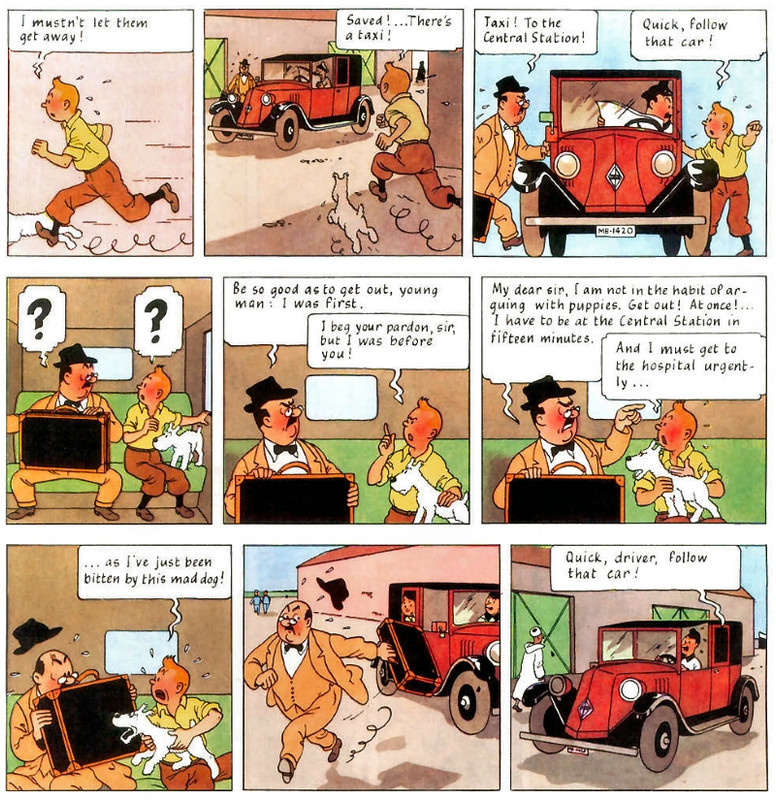
Criticisms about the humour aside, by far the most significant thing about
The Crab with the Golden Claws is the introduction of Captain Haddock. Hergé performs an absolute master stroke by introducing this irascible, drunken sea captain, who, with his incorrigible drinking, explosively quick temper, and unkempt appearance, is the perfect foil to the perennial "goody two-shoes" of Tintin. As the most important supporting character in the series, his first appearance and the pair's first meeting deserves to be reproduced as part of this review, I feel...

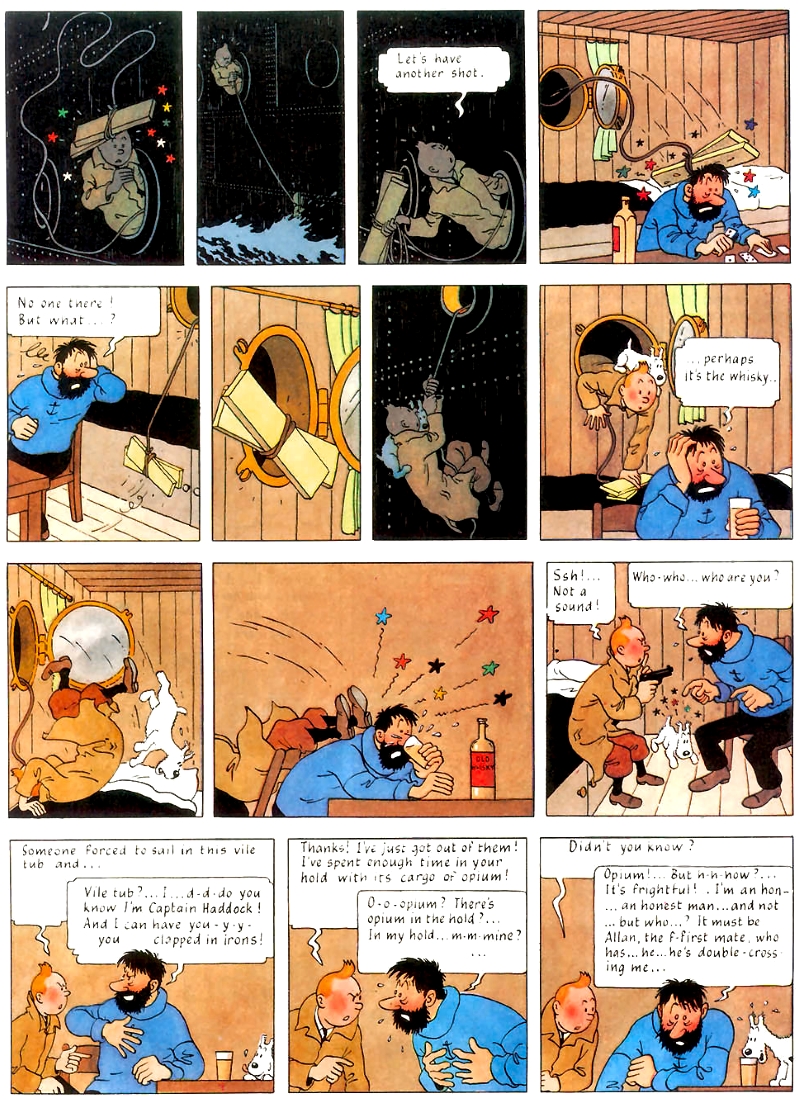

Note too, that we get the first "official" appearance of the Karaboudjan's treacherous first mate, Allan Thompson. Hergé saw fit to retroactively insert this flat-nosed, thuggish criminal into the earlier
Cigars of the Pharaoh, when it was redrawn in 1955, but this is Allan's first appearance, chronologically speaking.
Haddock, who has clearly spent many years at sea prior to meeting Tintin, is a brilliant creation – a headstrong, impulsive character, but fundamentally a decent man, albeit one bedevilled by the demon drink! In fact, the almost permanently sozzled Captain is a colossal pain in the arse and proves to be a total liability for Tintin throughout most of this adventure. At times, his inebriated foolishness makes him just as much of a danger to Tintin and Snowy as the story's villains! As the adventure progresses though, Haddock eventually comes into his own and stops being such an annoyance, turning instead into a genuinely funny creation. Still, following their initial meeting, it's sometimes hard to see why Tintin keeps the Captain around. But, of course, the young lad is a hero and, thus, he senses the innate goodness and potential within the drunken old soak. For his part, the boy reporter inspires the Captain with his selfless heroism, serving to slightly reform the cynical old sea dog by example and bring out his better nature.
Tintin also seems genuinely determined to help Haddock with his drink problem and, by the end of the story, the boy has seemingly saved him from drunken ruin, helping to cement a firm friendship between the pair and the Captain's lasting place in the series. The final page, in which the Captain is taken ill after drinking water is a delicious twist on his alcoholism. Unfortunately, Snowy's role in The Adventures of Tintin would, from here on out, diminish, as Haddock became the series' unquestioned co-star.
One of the absolute best things about Captain Haddock is that he is given to angry outbursts, consisting of streams of delightfully inventive, often irrelevant, and seemingly unlimited expletives. These hilarious tirades of the Captain's are an absolute treat and here's the very first time that the character really lets rip...

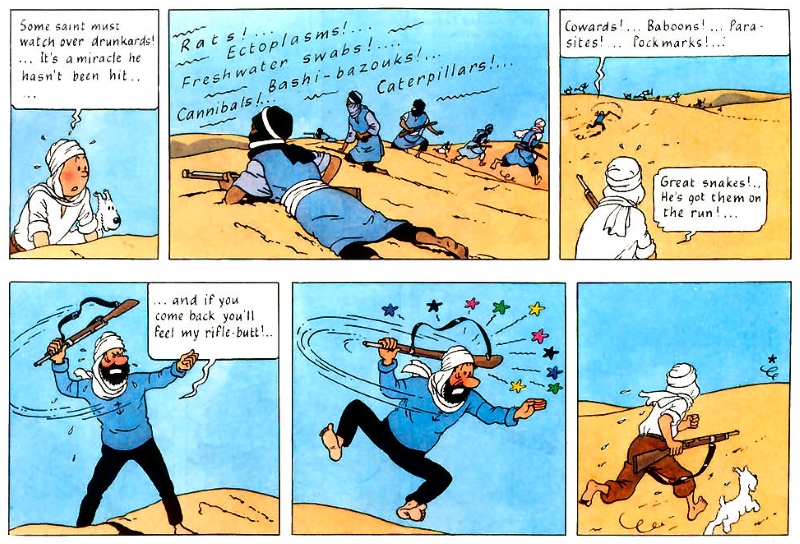
Being a vegetarian myself, I adore the fact that, later on in the book, Haddock even uses the word "Vegetarian!" as one of his colourful curses.

Still, as enjoyable as Haddock's salty insults are, one or two of the ones found in this book are uncomfortably dated by 21st century standards. At one point Haddock calls someone a "Fuzzy-wuzzy!", which is archaic, offensive British slang for any black, Afro-haired native of various foreign countries. He also uses the word "Negro!" as an insult at one point too, which made me wince.
However, in spite of these archaic racist terms, I think Hergé also attempts to play with the audience's prejudices in this book. Early on, we are introduced to a suspicious-looking Japanese man, who, to be frank, is rendered in a fairly racially insensitive way...
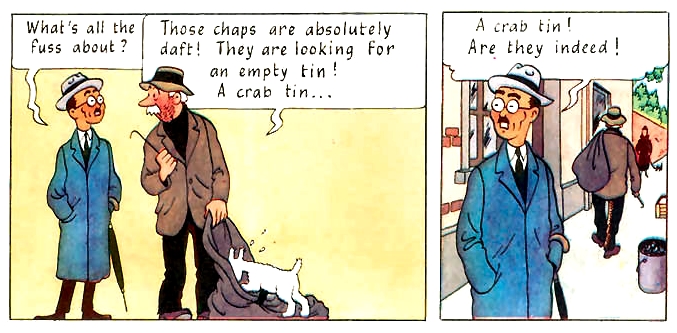
Now, there's little doubt in my mind that we, the readers, are supposed to suspect this Asian gentleman of being a criminal. However, at the story's conclusion, we learn that he is, in fact, a Japanese detective, who has been on the trail of "The Crab with the Golden Claws" drugs ring. Hergé's point being that you shouldn't assume anything based on a person's appearance. By the way, I love that the criminals have taken the trouble to give their opium smuggling operation such a wonderfully florid and elaborate name as "The Crab with the Golden Claws". You just don't get that kind of attention to detail from drugs smugglers these days.

Hergé's artwork in this book is an improvement on
King Ottokar's Sceptre – not that the art in that book was bad, but it did seem a little uneven and lacking in detail in places.
The Crab with the Golden Claws sees Hergé's highly detailed and superbly cinematic
ligne claire style firing on all cylinders. We also have big, full-page splash panels in this book, which is, stylistically speaking, something new for the series.
Although
The Crab with the Golden Claws is an important book, within the context of the series, I have to say that it's a somewhat patchy and uneven Tintin adventure overall. Bits of it – particularly the introduction of Captain Haddock, our heroes' escape from the Karaboudjan, and Tintin and the Captain's escapades in the Sahara Desert – are excellent (which is no doubt why directors Steven Spielberg and Peter Jackson so faithfully adapted those portions of the book for their 2011 computer-animated film,
The Adventures of Tintin: The Secret of the Unicorn). But a fair bit of this adventure is rather dull and there's far too much unfunny slapstick in it too, which slows down the narrative and causes the plot to meander on occasion. This is an uncharacteristically uninspired adventure for Hergé and I can't help feeling that it's little more than a tired retread of
Cigars of the Pharaoh.
Still,
The Crab with the Golden Claws marks the beginning of a new phase in The Adventures of Tintin, as Hergé permanently expands the cast with the monumental introduction of Captain Haddock. There's also an exotic, "pulpy" vibe to this tale, which I enjoy, but ultimately, that's not enough to make up for the slightly unfocused and lightweight nature of this adventure. While it's certainly an important installment of the series,
The Crab with the Golden Claws is also an oddly forgettable one.




 Still, the Asterix series could be a good subject for a review thread.
Still, the Asterix series could be a good subject for a review thread.

















